For a couple of weeks now I've been driving a Nissan Qashqai e-Power which, in my view, is; one of the most classic cars; interesting of the moment because of the technology with which it is; its propulsion system was designed. Yeah, that's right, Nissan sells this car as an electric car that doesn't need to be recharged, and it's a good choice. just like that. Although it is always and exclusively driven by an electric motor, it does not need to be connected to the socket in order to recharge the battery which is used to supply energy to the electric motor. And so how does it work? And above all how much does it consume? I'll tell you everything in the next few lines.
E-POWER TECHNOLOGY 

Let's start immediately with a quick overview of how the propulsion system of this Nissan Qashqai works. I will go fast enough because it is; We have already discussed this topic. dedicated a content of which I leave you the link here. First of all, it must be said that it is a very different solution compared to the classic hybrids, whether they are full or plug-in. In these two cases, in fact, the hybrid system is referred to as 'parallel', with both motors being connected to the wheels and both can therefore, together or alternately, propel the car.
In the case of the Nissan e- Power, on the other hand, the only engine actually connected to the wheels is the Power. the electric one. In fact, therefore, the behavior and feedback behind the wheel are the same as when we sit aboard a fully electric car. We therefore have the classic torque that is always immediately available, a discreet power, the absence of a gearbox and therefore that feeling of extreme fluidity. and comfort typical of electric cars.

So what is the thermal engine for? Simple, to generate the current needed to recharge the battery that powers the electric motor. Specifically, we are talking about a 158 HP three-cylinder turbo-petrol engine, which is more than 158 HP. than sufficient to generate the current necessary for the purpose just described. On the other hand, we have an electric engine with 140kW of power, or 190 HP, with a good 330 Nm of torque.
Between the two motors we find the inverter which takes care of directing the electricity generated by the thermal engine; towards the battery or directly towards the electric motor depending on the driving situation.
The battery on board also offers a capacity; of 1.8 kWhwhich, as an absolute value, are certainly few. Let's say that it follows the ability of “ of the battery of a classic Full Hybrid system which, in fact, can; travel in electric only just a handful of km. The difference here lies precisely in the fact that this battery is; constantly fed and therefore we could actually; almost considering it “infinite”.
HOW IT DRIVES AND HOW IT FEELS ON BOARD 
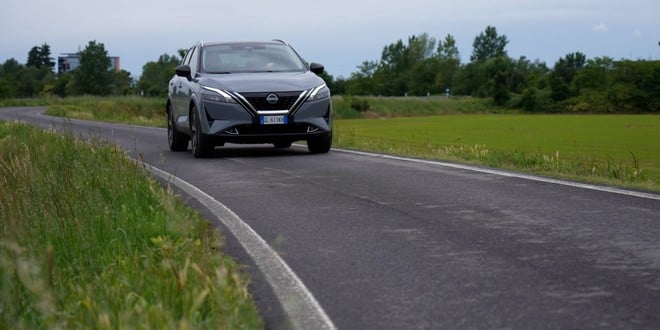
As mentioned above the feeling behind the wheel is; exactly that of being on board a fully electric car. Even the regeneration system is reminiscent in terms of intensity; that of a car powered only by an electron engine. And in addition; it is possible, as in all electrics, to activate the so-called one-pedal drive. By pressing the e-Pedal, buttonin fact, the highest level of regenerative braking is activated; pushed which, in fact, with some tricks, allows us to drive using practically a single pedal. In fact, the system significantly reduces the speed of the car. almost coming to a stop of the car. At this juncture, regeneration is essential. maximized and is; possible to add a little of autonomy to what would be the total number of km traveled with this function deactivated.
Always activating a key on the central dashboard we then have the possibility; to change the mode; driving going from Eco to Standard and finally to Sport. The mode Eco is the most thriftyfrom the point of view of consumption, but I advise you to use it only on fast-flowing roads or in any case on extra-urban roads where you will find yourself traveling several kilometers at a higher speed. constant. In a context more; as eventful as it can be; being city traffic, in fact, the power cut necessary to reduce consumption makes itself felt, shooting is much quicker; lens and, in general, it lacks quite a bit of responsiveness. In these situations it is much more; In my opinion, it is convenient to try to make the most of the e-Pedal and the regenerative braking.
The mode of the e-pedal. Sport, on the contrary, is; the one that maximizes performance even at the expense of a little of autonomy. In this case the internal combustion engine is; access much more; often and runs at higher revs. high, just to ensure that the electric always has the charge necessary to release all its horsepower.
Halfway through; road we find the modality; Standard that is the one I used for 90% of the km traveled in these two weeks. It's an excellent compromise, which manages to guarantee more performance; that good and absolutely low consumption, as we will see shortly. Let's talk more about the modality; active by default and, in fact, the one I recommend for everyday journeys.
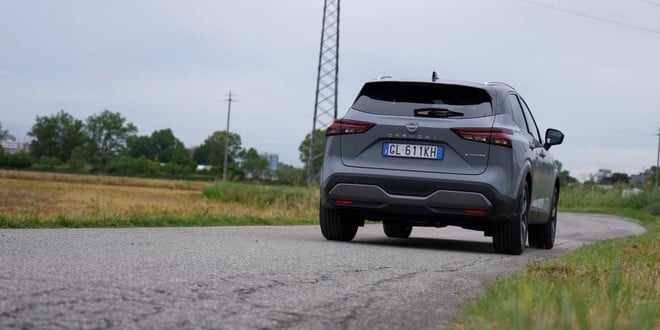
For the rest, I must admit that on board this Quashqai e-Power you travel really comfortably.Space on board is limited. both when we sit in the front seats and when we sit on the rear bench seat. Here, with the driver's seat positioned to accommodate a person of around 175/180cm we still have quite a bit of space to spare. of space available for the knees of those sitting behind, and the same amount of air above the head. Even the boot, with its over 500-litre capacity; (which reach over 1500 with the seats folded down), offers all the space needed to load a fair number of bags and luggage.
Everything is right. then made even more; comfortable from an extremely silent passenger compartment, finished with soft materials a bit everywhere to minimize vibration. The internal combustion engine feels very little, so much so that it is practically always covered by the normal aerodynamic noise and by the rolling of the tyres. In addition to this, to further increase the acoustic comfort of the driver and passengers accustomed to traveling in traditional cars, it is necessary to Linear Tune was created, a system that guarantees a direct connection between the number of revolutions of the internal combustion engine and the speed of the engine. of the car.
In short, someone who has had the opportunity to test various electric cars tells you that in the vast majority of cases it will seem to you that it is not easy to do it. absolutely to drive a completely electric car.
BUT HOW MUCH DOES IT CONSUMPTION? 
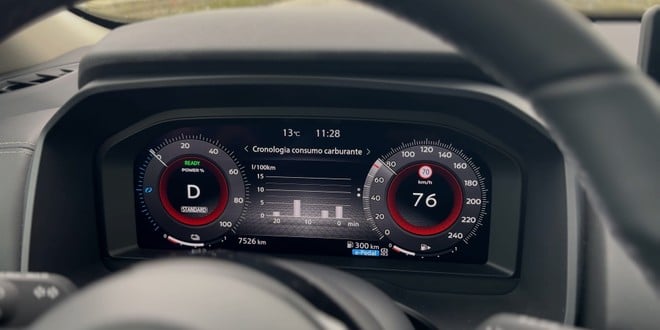
And here we are at the most important part. interesting part of today's article, because it is if I have had this Qashqai e-Power in my hands for the past two weeks, it is; just to try to understand if, as intended by the Japanese manufacturer, this type of engine is really capable of replacing the old Diesel in terms of range and fuel consumption.
First of all, let's say that my journey from home to work, which is then the one on which the commuter test is based, is; made up of urban and extra-urban roads, including state roads, ring roads and a few km in the city.The journey is; of about 50 km and it is; the typical journey that a classic commuter makes every day to move to and from the city; of Milan, with all the traffic that follows (aim` often very intense).
After about 10 days of round trips, I can therefore tell you that, depending on how much traffic is; intense the average of the consumptions can; therefore varying from about 5 liters per 100 km to something less than 4 liters per 100 km.In particular more the traffic becomes more intense the more; consumption drops, a typical behavior of hybrid cars. In a couple of trips to Milan, I even managed to obtain an average consumption of 3.8 liters per 100 km on arrival, which is more than the average fuel consumption. of 25 km with a liter of petrol.
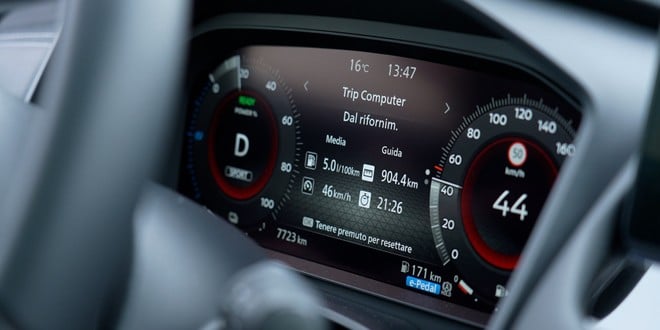
In the worst case, however, the average is was 5.1 liters per 100 km, or just under 20 km per litre. Entering the city, taking advantage of the regenerative braking and speed; more low it is almost always around 4 liters per 100 km which rises instead to around 5 in the countryside routes of the Milanese hinterland. In short, considering the weight of the car and its dimensions, it is a good idea. definitely what I would call 'a good go'.
And on the motorway at high speeds. of code? Let's say that, as also for electric cars, this is the best choice. the situation a little more; complicated to manage and the one where the internal combustion engine stays on for longer; time and at higher revs; elevated. During my two weeks in the company of him, it was a pleasure for me. happened to face a couple of journeys on the motorway, for a total of about 200km travelled. On these occasions, the average is always oscillating between 6.2 and 6.4 liters per 100 km, i.e. 15-16 km per litre. They are certainly higher averages. higher than usual daily mileages but we are still in line with the consumption of the 150 bhp 1.7 dCi which was on the price list in previous generations of Qashqai.
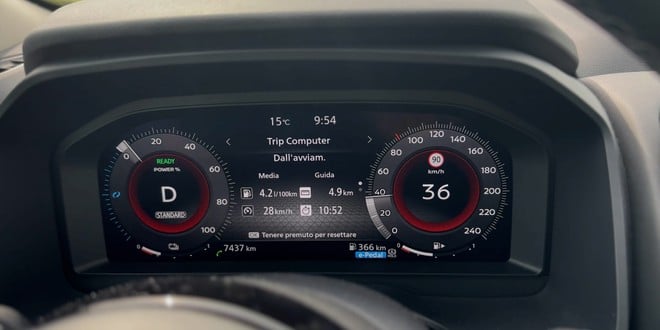
At the end of my 15 days of use la total average recorded from the time the on-board computer was reset (coinciding with the full tank), it is; was exactly 5.1 liters per 100 km,or just under 20 km per litre. A fact that, in fact, is even better than the average in the combined WLTP cycle declared by Nissan (5.5 liters per 100 km according to the manufacturer), and which is; was also confirmed by the topping up test. With exactly 32 liters of fuel consumed and 617 km travelled, we have a real average of 19.3 km with one liter and another 400 km that can be easily covered with the remaining 23 liters available. The 1000 km on a full tank declared by Nissan during the promotion are therefore absolutely achievable. A milestone that is certainly important and that I would hardly have predicted considering the type of car.
CONSIDERATIONS 
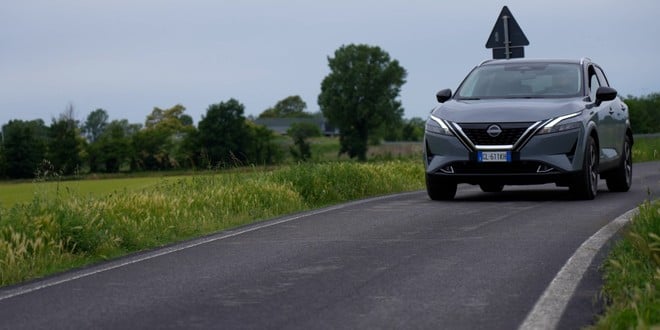
What to say then? If Nissan's intent with this e-Power was really to replace the old diesel engines, we can say that, at least in terms of guaranteed autonomy, the mission is the same. substantially accomplished. There is then the emissions component must also be considered which, needless to say, are decidedly lower both than those of the old diesel engines and those of many recent petrol engines. In short, the advantages are many and this Qashqai e-Power can be used in many ways. be considered the perfect solution for all those whothey are somehow attracted by the driving sensations that one gets behind the wheel of a fully electric car but which, at the same time, do not have the possibility; to recharge it in a simple and regular way, or they still can't afford one because of the costs.
Yeah, because it's too expensive. this Qashqai e-Power starts from the Acenta set-up and costs 37,320 euros , which are less than many, if not all electric cars of the same size, and around 2,500 euros more. of the 158 hp Mild-Hybrid model with automatic transmission in the same set-up. A difference in price which, in my opinion, is absolutely justified by the greater power of the engine and by the lower fuel consumption and emissions, as well as by a set-up which, in any case, while remaining an Acenta, provides for a few more optionals, such as the 18 alloy, against 17 of the MHEV model.
NISSAN ONLINE CONFIGURATOR
VIDEO
The perfect smartphone for the mid-range ? Poco F5, buy it at the best price from Amazon at 399 euros.